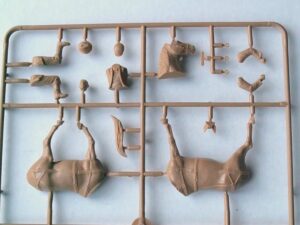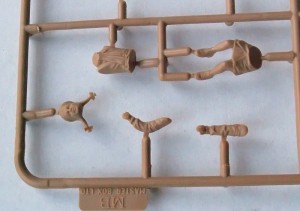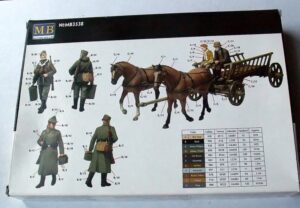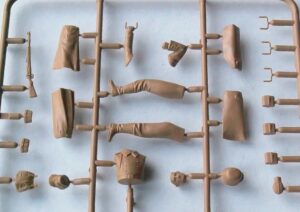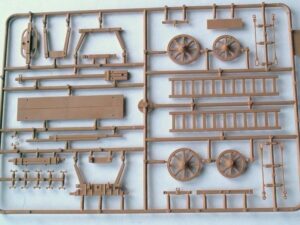It is time for yet another review of historical models in 1/35 scale. I’m gonna cover Master Box LTD company of Ukraine, and their “Somewhere in Europe… 1944” set.
Introduction
I found these models by accident while searching for horses. This box includes two nags, two Germans, grandpa with granddaughter and a cart. Germans are also available separately in the “Supplies, at last!” box, and the cart in the “Farmers Cart” box, Europe, WWII Era.
4 human models, 2 horses and the cart were very cheap, so I didn’t hesitate to buy that set.
Models
These multi-part models are made of plastic and come in sprues. I know quality and precision some companies provide for models cast in plastic, so I was quite scared… horse is made of 5 elements, but there are about 23 pieces for a soldier. Frankly speaking you don’t have to use all these bits, but you need about 12 bits to make a soldier without the equipment. I was then really surprised, because elements could be removed from sprues easily, and mould lines disappeared after short sanding. I also found that the manufacturer provided additional bits, so we can personalize their models, e.g. there are 2 different headgears or water bottles in excess.
Gluing
The best glue for these models is glue for plastic elements. Standard cyanoacrylate super glues should be avoided.
Seriously, both material and parts were meant to be glued with the glue for plastic elements. Bits have excessive material which gets melted by glue. This automatically fills gap between two parts. That was another big surprise. Some of the bits looked unfriendly in sprues, even worse after removal. Nevertheless, after gluing almost all pieces fit perfectly! If there was something wrong it was usually because I’d forgotten about few pieces (like haversack or pouches).
Details
The general level of details is pretty good, especially considering the material. Of course, details are not as deep as in resin models. Also, newer models have more details sculpted. I was able to check contents of few more boxes. Those released in the past are pretty simple, while new sculpts are looking much better and have lot of details. The set I purchased is somewhere in between when it comes to details and sculpt quality. By the way, there are no nails sculpted on fingers, I think all historical models have the same issue.
Cons
- plastic, not resin – quality of details,
- be careful while cleaning the model. Material is quite soft, you can easily scrape details off.
Pros
- price!!
- general quality,
- range (see below).
Range (a.k.a. what I have seen)
Models in 1/35 scale are usually not to my liking due to very stiff poses. Soldiers stand at attention, point a finger at something, shoot from the hip or crawl – all of that like they had a long and stiff stick in their… well, you know where.
I was therefore even more surprised to see that soldier with a bin assuming a very easy stance; his mate also looks like an easy fellow. This made me check other products released by that company. It looks like there is more “easy” sculpts and several very dynamic ones. I recommend taking a closer look at:
- “Frontier fight of summer 1941, hand to hand combat (4 fig.)” – hand to hand combat with helmets and shovels??
- “Skatspieler” – soldiers playing cards.
- “Casualty Evacuation”, German Infantry, Stalingrad, Summer 1942 – rarely seen scene with wounded/killed soldiers
- “Deutsches Afrika Korps, WWII Era” – repair workshop.
There is more of that; and some civilians too.
I also suggest you find the diorama produced by Kenichiro Hebitsuka from Japan on the manufacturer’s website – it clearly shows what you can make out of these models.
Painting
I haven’t observed any bad reaction between the material and spray primer or any signs of wearing.
I painted mine for the 5th Chest of Colors Miniature Exchange and painting process was fun and quick. I’d love to use oils for few elements, but lifted that idea due to time constraints. Anyway, these models surely can be painted with oils. The only lacking thing were deeper details characteristic for resin models. Newer models are much better with regards to details though.
True historical colour scheme is shown on the box with reference to specific paints given (Vallejo, Tamiya, Lifecolor, Humbrol, Agama). Of course, you can always check available publications (e.g. Osprey books) by yourself or paint a model as you wish.
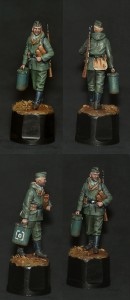
Verdict
I don’t think you will find a better quality/price ration within this price range. The casting quality is not as good as in case of resin models, but many of these models would look better than standard resin models, especially “top sets” like “US Check Point in Iraq /3591/”. A box with 2 – 5 models with loads of equipment will cost 15 – 45 PLN (4 – 10€, 5 – 15 $), and “MB 3560 German Motorcycle Repair Crew (1:35)” set comprising a full diorama with 4 soldiers, table and motorcycle stripped to pieces costs about 60 PLN (14 €, 18 $).
My opinion is that this is a very good offer for people who want to try a new scale or new techniques (oils, anyone?). You will not despair if something goes wrong due to low prices. Of course, advanced painters could easily make a masterpiece of these models like Kenichiro Hebitsuka did.
— Maru



